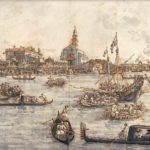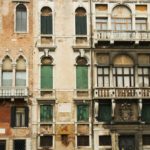In the marginalia of so many of these books, are readers’ comments and annotations in a number of different languages in a single volume – Italian, Russian, Yiddish, Polish…
The Library of Congress holds 675 volumes printed either partly or entirely in Hebrew during the sixteenth century. Many, though not all, of these books came to the Library via Ephraim Deinard, the legendary bookseller and bibliophile whose collections, purchased through the generosity of Jacob H. Schiff in 1912 and 1914, form the nucleus of the Hebraic Section at the Library of Congress.
Among the Venetian volumes are the first Rabbinic Bible (Venice, 1517), 22 of the 44 tractates of the precious first edition of the Babylonian Talmud, printed by Daniel Bomberg (Venice, 1520-1523), the first Jerusalem Talmud (Venice, 1522-1523), the first Karaite prayer book (Venice, 1528-1529), the first printed novella by Nahmanides (Venice, 1523), the first book with a Hebrew map of the New World: Iggeret Orhot Olam (Venice, 1586), and the rhymed tales of Mashal ha-Kadmoni with their charming woodcut illustrations (Venice, ca. 1547).
The Hebraic collections of the Library of Congress came into being in the nineteenth century thanks to the inspiration of Ephraim Deinard and the efforts of Cyrus Adler, Herbert Putnam, and Jacob Schiff.
Ephraim Deinard, born in the Baltic region of the Tsarist Empire toward the middle of the nineteenth century was revered as a traveler, dealer—primarily—in antiquarian Jewish books and manuscripts, ancient coins and sundry art objects, prolific Hebrew author, editor, bibliographer, early Zionist activist, advocate of agricultural settlement of Russian Jews, developer, controversialist and past master of Hebrew invective. He spent his formative years in Lithuania, moved to White Russia where he married in the mid-1860s, and went on to the Crimea where he briefly became the amanuensis and factotum of the Karaite champion Abraham Firkovitch. in the early 1880s Deinard was a proprietor of a bookstore in Odessa. He traveled twice to the Holy Land in 1880 on a reconnaissance mission for prospective settlement, and after the pogroms began in 1881 in the wake of the assassination of Tsar Alexander II, Deinard led a large party of Russian-Jewish refugees to Constantinople (in May of 1882) seeking permission to settle in Palestine.
On October 6, 1888, Deinard arrived in the United States from Liverpool, accompanied by a wife, four young daughters, and a niece—and 11 pieces of luggage. The luggage contained Deinard’s stock for trade, Hebrew printed books and manuscripts. It was a rather lengthy trip from Odessa—the family had set out in January but he spent the first eight months zigzagging through various Russian cities, plying his trade, replenishing his purse, observing the state of the incipient Zionist movement, and awaiting exit documents. (He parked the family in Vilnius.) Ephraim Deinard was to disembark in the port of New York after successful acquisitions trips six more times in his final 42 years.
His early years in America were also years of frenetic activity. He applied for naturalization two months after he landed. He began to publish a Hebrew “nationalist” weekly on a press he set up in his home on Orchard Street. He soon moved the press to Newark —where he was to live for some three decades—on which he produced a parody, a satire, essays mingling musings on the future of the Jews with bitter memories, and polemics—always polemics. He started a Yiddish weekly and worked on a catalog of the stocks of two New York Hebrew bookdealers.
He partook in a fiasco, attempting to found an agricultural colony in California. Other projects he planned also died aborning: a Hebrew periodical, a catalog of the library of the Jewish Theological Seminary and 15 trips around the world to exotic Jewish communities.
In the first half of his life, back in Europe, Deinard had been a purveyor of manuscripts and rare books to some of the great libraries—and particularly to the national libraries, viz. the British Museum, the Bibliothèque Nationale,
It obviously occurred to him—I cannot say when but certainly quite early, perhaps even well before he got here—that the United States also had a national library and it was terra incognita. To lobby for his agenda, Deinard joined the American Oriental Society in 1894 and attended the Congress of Philologists held at the University of Pennsylvania during the last week of that year where seven American learned societies convened to honor the memory of William Dwight Whitney, the recently-deceased Sanskritist and English lexicographer.
At a meeting of the AOS, Deinard delivered a paper on the Subbotniki and spoke a second time, as well. The subject of the second talk I have not found reported in the press, but he relates in two of his books that he proposed the establishment of a large collection of Hebrew works at the Library of Congress that would serve the needs of the American scholar, for he found it appalling that scholars in the United States wanting old Hebrew books would have to travel to the British Museum or the Bodleian Library to consult them. “Is it not a disgrace,” he writes, “for our rich country, in general, and for its Jewish citizens, in particular?” According to Deinard, his proposal was supported by Daniel Coit Gilman, President of Johns Hopkins University, who by chance happened to be the president of the American Oriental Society that year. Gilman supported the idea but Cyrus Adler, then Librarian of the Smithsonian Institution, opposed it. Deinard does not tell us why, but there is a suggestion in his turn of phrase that Adler believed that the time was not ripe yet.
Library of Congress, early 20th century
I would like to call your attention to the fact that …, I have been collecting Hebrew books . . . the oldest and rarest books … about 10,000. I would like to sell my entire library . . . Every official library in civilized Europe contains a Hebrew department . . . and I think it would be very advantageous to the Congress Library . . . Ephraim Deinard, 1909
To compare the morals of the old, with those of the new testament, would require an attentive study of the former, a search thro’ all it’s books for it’s precepts, and through all it’s history for it’s practices, and the principles they prove, as commentaries too on these, the philosophy of the Hebrews must be enquired into, their Mishna, their Gemara, Cabbala, Jezirah, Sohar, Cosri and their Talmud must be examined and understood, in order to do them full justice.
Brucker, it should seem, has gone deeply into these Repositories of their ethics, and Enfield, his epitomiser, concludes in these words. ‘Ethics were so little studied among the Jews, that, in their whole compilation called the Talmud, there is only one treatise on moral subjects — their books of Morals chiefly consisted in a minute enumeration of duties. From the law of Moses were deduced 613 precepts, which were divided into two classes, affirmative and negative, 248 in the former, and 365 in the latter —it may serve to give the reader some idea of the low state of moral philosophy among the Jews in the Middle age, to add, that of the 248. affirmative precepts, only 3 were considered as obligatory upon women […] the observance of the rest being deemed necessary, only to increase the felicity of the future life. What a wretched depravity of sentiment and manners must have prevailed before such corrupt maxims could have obtained credit! It is impossible to collect from these writings a consistent series of moral Doctrine.’ Thomas Jefferson 1813
If I had Eyes and Nerves I would go through both Testaments and mark all that I understand. To examine the Mishna Gemara Cabbala Jezirah, Sohar Cosri and Talmud of the Hebrew would require the life of Methuselah, and after all, his 969 Years would be wasted to very little purpose. The Daemon of Hierarchial despotism has been at Work, both with the Mishna and Gemara.
In 1238 a French Jew, made a discovery to the Pope . . . of the heresies of the Talmud. The Pope sent 35 Articles of Error, to the Archbishops of France, requiring them to seize the books of the Jews, and burn all that contained any Errors. He wrote in the same terms to the Kings of France, England Arragon, Castile Leon, Navarre and Portugal. In consequence of this Order 20 Cartloads of Hebrew Books were burnt in France: and how many times 20 Cartloads were destroyed in the other Kingdoms? The Talmud of Babylon and that of Jerusalem were composed 120 to 500 Years after the destruction of Jerusalem. If [John] Lightfoot derived Light from what escaped from . . . [the Pope’s] fury in explaining many passages in the New Testament by comparing the Expressions of the Mishna, with those of the Apostles and Evangelists, how many proofs of the Corruptions of Christianity might we find in the Passages burnt? John Adams, 1813
The Hebrew language is very dear to me. I have made it my cherished study from childhood to old age. In it my mother delighted to hear her boy chant benedictions and hymns. It has proved, moreover, a solace to my heart in many a vicissitude. Sabato Morais, Philadelphia 1892
References: Ann Brener, The Hebraic Collection of the Library of Congress, Myron M. Weinstein, The First Deinard Collection of the Library of Congress, 2006, Gerd Korman, Jews as a Changing People of the Talmud: An. American Exploration, 2001.



